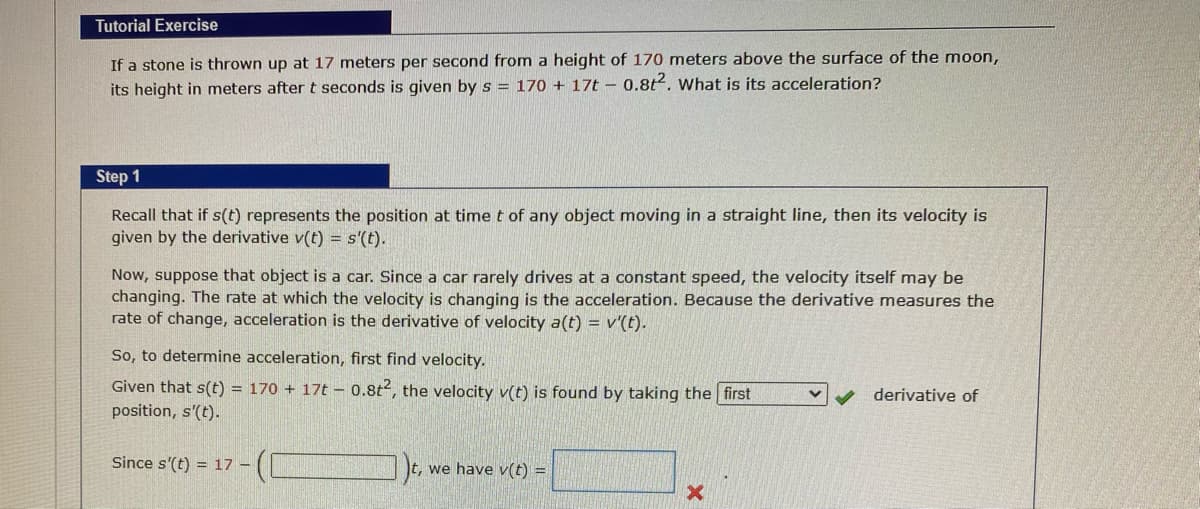Tutorial Exercise If a stone is thrown up at 17 meters per second from a height of 170 meters above the surface of the moon, its height in meters after t seconds is given by s = 170 + 17t - 0.8t. What is its acceleration? Step 1 Recall that if s(t) represents the position at time t of any object moving in a straight line, then its velocity is given by the derivative v(t) = s'(t). Now, suppose that object is a car. Since a car rarely drives at a constant speed, the velocity itself may be changing. The rate at which the velocity is changing is the acceleration. Because the derivative measures the rate of change, acceleration is the derivative of velocity a(t) = v'(t). So, to determine acceleration, first find velocity. Given that s(t) = 170 + 17t – 0.8t, the velocity v(t) is found by taking the first position, s'(t). derivative of Since s'(t) = 17 - t, we have v(t) =
Tutorial Exercise If a stone is thrown up at 17 meters per second from a height of 170 meters above the surface of the moon, its height in meters after t seconds is given by s = 170 + 17t - 0.8t. What is its acceleration? Step 1 Recall that if s(t) represents the position at time t of any object moving in a straight line, then its velocity is given by the derivative v(t) = s'(t). Now, suppose that object is a car. Since a car rarely drives at a constant speed, the velocity itself may be changing. The rate at which the velocity is changing is the acceleration. Because the derivative measures the rate of change, acceleration is the derivative of velocity a(t) = v'(t). So, to determine acceleration, first find velocity. Given that s(t) = 170 + 17t – 0.8t, the velocity v(t) is found by taking the first position, s'(t). derivative of Since s'(t) = 17 - t, we have v(t) =
Big Ideas Math A Bridge To Success Algebra 1: Student Edition 2015
1st Edition
ISBN:9781680331141
Author:HOUGHTON MIFFLIN HARCOURT
Publisher:HOUGHTON MIFFLIN HARCOURT
Chapter8: Graphing Quadratic Functions
Section: Chapter Questions
Problem 30CR
Related questions
Question
If a stone is thrown up at 17 m/s from a height of 170 m above the surface of The moon, its height in meters after 30 seconds is given by s=170+17t-0.8t^2. What is its acceleration?
(PLEASE TYPE OUT IF POSSIBLE)

Transcribed Image Text:Tutorial Exercise
If a stone is thrown up at 17 meters per second from a height of 170 meters above the surface of the moon,
its height in meters after t seconds is given by s = 170 + 17t – 0.8t. What is its acceleration?
Step 1
Recall that if s(t) represents the position at timet of any object moving in a straight line, then its velocity is
given by the derivative v(t) = s'(t).
Now, suppose that object is a car. Since a car rarely drives at a constant speed, the velocity itself may be
changing. The rate at which the velocity is changing is the acceleration. Because the derivative measures the
rate of change, acceleration is the derivative of velocity a(t) = v'(t).
So, to determine acceleration, first find velocity.
Given that s(t) = 170 + 17t - 0.8t2, the velocity v(t) is found by taking the first
position, s'(t).
derivative of
Since s'(t) = 17 -
we have v(t) =
Expert Solution
This question has been solved!
Explore an expertly crafted, step-by-step solution for a thorough understanding of key concepts.
Step by step
Solved in 2 steps

Knowledge Booster
Learn more about
Need a deep-dive on the concept behind this application? Look no further. Learn more about this topic, calculus and related others by exploring similar questions and additional content below.Recommended textbooks for you

Big Ideas Math A Bridge To Success Algebra 1: Stu…
Algebra
ISBN:
9781680331141
Author:
HOUGHTON MIFFLIN HARCOURT
Publisher:
Houghton Mifflin Harcourt

Functions and Change: A Modeling Approach to Coll…
Algebra
ISBN:
9781337111348
Author:
Bruce Crauder, Benny Evans, Alan Noell
Publisher:
Cengage Learning

Big Ideas Math A Bridge To Success Algebra 1: Stu…
Algebra
ISBN:
9781680331141
Author:
HOUGHTON MIFFLIN HARCOURT
Publisher:
Houghton Mifflin Harcourt

Functions and Change: A Modeling Approach to Coll…
Algebra
ISBN:
9781337111348
Author:
Bruce Crauder, Benny Evans, Alan Noell
Publisher:
Cengage Learning